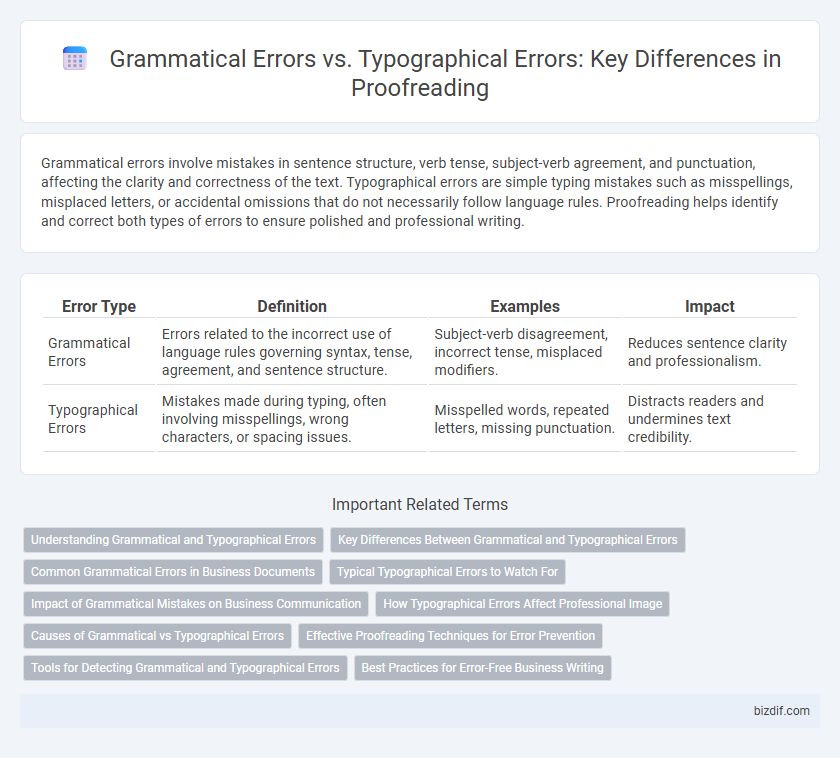Grammatical errors involve mistakes in sentence structure, verb tense, subject-verb agreement, and punctuation, affecting the clarity and correctness of the text. Typographical errors are simple typing mistakes such as misspellings, misplaced letters, or accidental omissions that do not necessarily follow language rules. Proofreading helps identify and correct both types of errors to ensure polished and professional writing.
Table of Comparison
| Error Type | Definition | Examples | Impact |
|---|---|---|---|
| Grammatical Errors | Errors related to the incorrect use of language rules governing syntax, tense, agreement, and sentence structure. | Subject-verb disagreement, incorrect tense, misplaced modifiers. | Reduces sentence clarity and professionalism. |
| Typographical Errors | Mistakes made during typing, often involving misspellings, wrong characters, or spacing issues. | Misspelled words, repeated letters, missing punctuation. | Distracts readers and undermines text credibility. |
Understanding Grammatical and Typographical Errors
Grammatical errors involve incorrect use of language rules, such as subject-verb agreement, tense consistency, and sentence structure, affecting clarity and meaning. Typographical errors are mistakes made during typing, including misspellings, misplaced punctuation, and accidental keystrokes that do not adhere to standard spelling conventions. Differentiating these errors is essential for effective proofreading, as grammatical errors impact sentence correctness while typographical errors primarily affect text presentation.
Key Differences Between Grammatical and Typographical Errors
Grammatical errors involve mistakes in sentence structure, verb tense, punctuation, and syntax that affect the clarity and correctness of a sentence, while typographical errors are accidental keystroke mistakes such as misspellings, misplaced letters, or missing characters. Key differences include the source of the error: grammatical mistakes stem from misunderstanding language rules, whereas typographical errors arise from manual input slips. Effective proofreading targets both types by applying linguistic knowledge for grammar and meticulous text scanning for typographical corrections.
Common Grammatical Errors in Business Documents
Common grammatical errors in business documents include subject-verb agreement mistakes, incorrect verb tenses, and misplaced modifiers, all of which can undermine professionalism and clarity. These errors often lead to misinterpretation, affecting the document's effectiveness and the organization's credibility. Careful proofreading to identify and correct these mistakes is essential for maintaining clear and authoritative business communication.
Typical Typographical Errors to Watch For
Typical typographical errors to watch for include transposed letters, such as typing "teh" instead of "the," and repeated characters like "loose" instead of "lose." Common mistakes also involve missing spaces or incorrect capitalization that can alter sentence clarity. Identifying these errors is crucial in proofreading to ensure text accuracy and readability.
Impact of Grammatical Mistakes on Business Communication
Grammatical mistakes in business communication can lead to misunderstandings, damage professional credibility, and reduce the effectiveness of the message. These errors often confuse readers or make the content appear unprofessional, potentially harming brand reputation and client trust. Unlike typographical errors, which are mostly cosmetic, grammatical errors directly affect clarity and the perceived competence of the communicator.
How Typographical Errors Affect Professional Image
Typographical errors, often overlooked as minor mistakes, significantly undermine a professional image by conveying carelessness or lack of attention to detail. Unlike grammatical errors, which can sometimes be nuanced or subjective, typographical errors are blatant and immediately noticeable, impacting readability and trustworthiness. Maintaining error-free documents is crucial for establishing credibility and fostering positive perceptions in professional communication.
Causes of Grammatical vs Typographical Errors
Grammatical errors primarily arise from misunderstandings of language rules, including syntax, verb tense, and subject-verb agreement, often caused by insufficient knowledge or complex sentence structures. Typographical errors are usually the result of manual input mistakes such as slips in typing, keyboard proximity issues, or hurried writing. While grammatical errors reflect linguistic comprehension problems, typographical errors generally stem from physical input errors or lapses in attention during the writing process.
Effective Proofreading Techniques for Error Prevention
Grammatical errors involve incorrect sentence structures, verb tenses, or subject-verb agreement, whereas typographical errors are mistakes in typing such as misspellings or misplaced characters. Effective proofreading techniques for error prevention include reading aloud to catch inconsistencies and using digital tools with grammar and spell-check features to identify both types of errors. Incorporating multiple review stages and focusing on one type of error at a time enhances error detection accuracy.
Tools for Detecting Grammatical and Typographical Errors
Advanced proofreading tools like Grammarly and ProWritingAid excel at detecting grammatical errors through syntax analysis and contextual understanding. For typographical errors, spell-checkers embedded in word processors such as Microsoft Word or Google Docs use extensive dictionaries to identify misspellings and common mistypes. Integrating AI-powered tools enhances accuracy by simultaneously targeting grammar and typos, streamlining the proofreading process for professional editors and writers.
Best Practices for Error-Free Business Writing
Grammatical errors, such as incorrect verb tense and subject-verb agreement, undermine clarity and professionalism in business writing, while typographical errors, including misspellings and misplaced punctuation, weaken the overall presentation and reader trust. Employing thorough proofreading techniques, such as reading aloud, using grammar-check tools like Grammarly, and reviewing documents multiple times, effectively minimizes these errors. Consistently applying style guides tailored to business communication ensures polished, error-free content that enhances credibility and reader comprehension.
Grammatical errors vs Typographical errors Infographic

 bizdif.com
bizdif.com